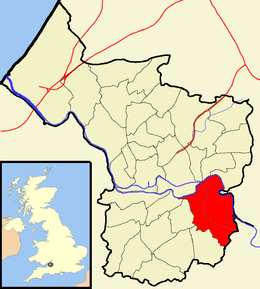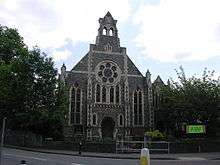Brislington
| Brislington | |
 Brislington West and East wards shown within Bristol. |
|
 Brislington |
|
| Population | 11,511 (2011.Wards)(East)[1] 10,636 (West)[2] |
|---|---|
| OS grid reference | ST622704 |
| Unitary authority | Bristol |
| Region | South West |
| Country | England |
| Sovereign state | United Kingdom |
| Post town | BRISTOL |
| Postcode district | BS4 |
| Dialling code | 0117 |
| Police | Avon and Somerset |
| Fire | Avon |
| Ambulance | South Western |
| EU Parliament | South West England |
| UK Parliament | Bristol East |
Coordinates: 51°25′54″N 2°32′38″W / 51.4316°N 2.5439°W
Brislington is an area in the south east of the city of Bristol, England. It is on the edge of Bristol and 10 miles (16 km) from Bath. The Froome, locally nowadays called the Brislington Brook, runs through the area in the woodlands of Nightingale Valley. Brislington houses the HTV West Studios on Bath Road and this is situated next to the historic Arnos Vale Cemetery which is currently undergoing restoration after a lengthy public and newspaper campaign.
History
The parish of Brislington was historically part of the Keynsham Hundred in Somerset,[3]
Brislington is also near to the site of the now demolished chapel of St. Anne's-in-the Wood (actually located in nearby St Anne's), erected by one of the Lords de la Warr, whose family held the manor of Brislington from the late 12th to the mid-16th century; in the 15th century the chapel was a place of pilgrimage, visited by Henry VII). After the chapel was demolished following the Dissolution of the Monasteries, a house called "St. Ann's" was built at the site by Thomas Avery in the mid-17th century.[4] During the 18th and 19th century Brislington contained many country homes due to its reputation as a picturesque country village.
Brislington House (now known as Long Fox Manor) was built as a private lunatic asylum for the insane. When it opened in 1806 it was one of the first purpose built asylums in England.[5][6][7] The Palladian fronted building was originally seven separate blocks into which patients were allocated depending on their class. The buildings, estate and therapeutic regime designed by Edward Long Fox was based on the principles of moral treatment which was fashionable at the time. Brislington House later influenced the design and construction of other asylums and influenced Act of parliament. The house and ancillary structures are listed buildings which have now been converted into private residences. The original grounds are Grade II* listed on the Register of Historic Parks and Gardens of special historic interest in England and now include St. Brendan's Sixth Form College, sports pitches and some farmland. They are now included on the Heritage at Risk register.
In 1866 Brislington became a civil parish. By the early 20th century it was encompassed by Bristol, and much urban housing and industry developed. In 1933 the civil parish was abolished and absorbed into Bristol.[8]

Churches in Brislington include St Lukes (which dates from the 15th century) and includes a bell dating from 1766 and made by Thomas Bilbie of the Bilbie family,[9] St Cuthberts, Carmel Christian Centre, St Christophers and the United Reformed Church.
Brislington used to have a station on the Bristol and North Somerset Railway (later the Great Western Railway) that linked the city with the towns of the Somerset coalfield. The line opened in 1873 and was closed to passenger traffic in 1959, with freight services withdrawn in the mid 1960s.
In the early 21st century, Brislington's paint works was converted to studios, offices and houses, home to arts and media organisations.

Education
The area is home to CLC@Brislington, one of Bristol's three City Learning Centres, which use information communication technology in teaching and learning.
Schools in Brislington include St. Brendan's Sixth Form College, Holymead Junior School, Broomhill Junior and Infant School, West Town Lane Primary School, and Oasis Academy Brislington, a local secondary school.
Sport and leisure
Brislington has a Non-League football club Brislington F.C. who play at Ironmould Lane and a rugby union club, Old Redcliffians who play in National League 3 South West, a fifth level league in the English rugby union system.
References
- ↑ "Brislington East" (PDF). 2001 Census Ward Information Sheet. Retrieved 21 February 2007.
- ↑ "Brislington West" (PDF). 2001 Census Ward Information Sheet. Retrieved 21 February 2007.
- ↑ "Somerset Hundreds". GENUKI. Retrieved 15 October 2011.
- ↑ Gertrude Euphemia Meredith, The descendants of Hugh Amory: 1605–1805, 1901p. 14.
- ↑ "Brislington House". English Heritage. Retrieved 11 October 2013.
- ↑ "Therapeutic theories of segregation and classification". National Archives. Retrieved 12 October 2013.
- ↑ "Brislington House, Bath Road, Bristol". Heritage Explorer. English Heritage. Retrieved 12 October 2013.
- ↑ Vision of Britain: Brislington CP
- ↑ Moore, James; Roy Rice; Ernest Hucker (1995). Bilbie and the Chew Valley clock makers. The authors. ISBN 0-9526702-0-8.
External links
| Wikimedia Commons has media related to Brislington. |
- Article on St. Anne's in the Wood
- Brislington Conservation and Historical Society
- Brislington Cricketers FC
- Brislington FC
- Friends of Arno's Vale
- The Paintworks
- The City Learning Centre at Brislington Enterprise College
- Brislington on GENUKI
- Brislington Community Archaeology Project
- Virtual Museum of Brislington